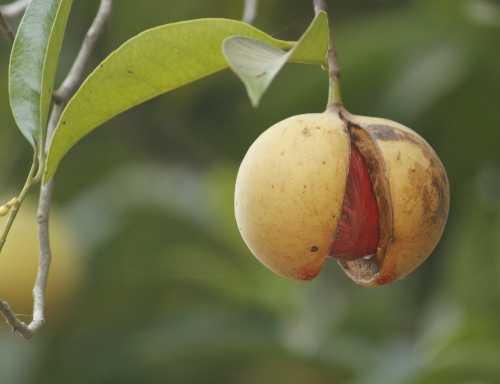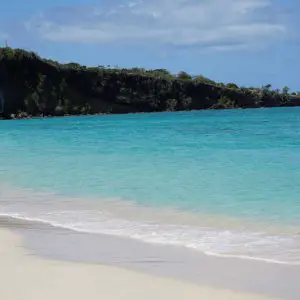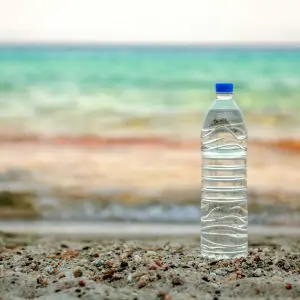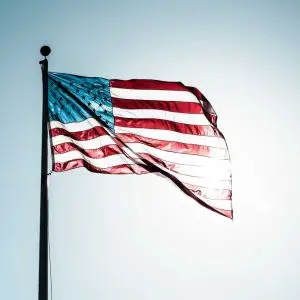You’re ready to escape to a Caribbean destination and narrowed it down to Grenada or Jamaica. But which one is the best island paradise for you? While Jamaica is an established vacation destination, Grenada remains an island paradise less traveled. Grenada has the infrastructure in place to accommodate tourists but isn’t currently as popular with tourists as Jamaica is. Both are great options for a vacation, although each offers a different experience for travelers. Keep reading and you’ll discover not only the similarities with Grenada and Jamaica but also (perhaps more importantly) the differences so you can make the ultimate best choice.
Should you go to Grenada or Jamaica on vacation? People looking for a more ‘off-the-beaten’ track destination should opt for Grenada, while tourists looking to hit up an established travel hotspot will enjoy Jamaica.

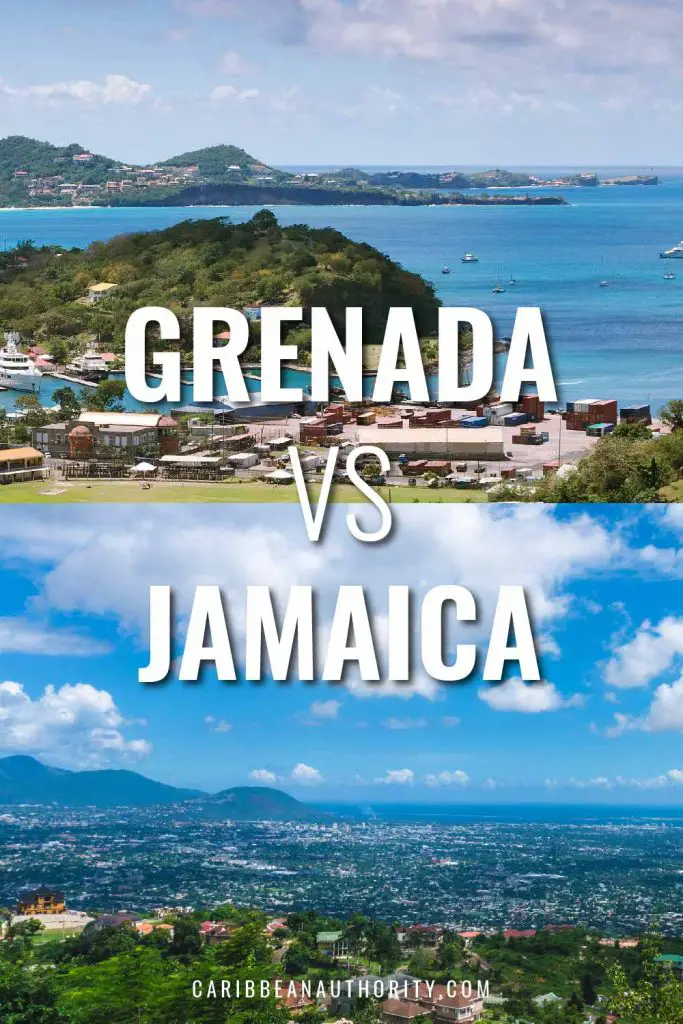
In this article, we’ll take a look at a range of factors to see what differentiates the two island countries, including:
- Geography
- Culture
- Food
- Crowds/Touristy
- Hurricane Likelihood
But before we get into the differences, let’s identify the similarities.
Grenada and Jamaica Similarities
There are many similarities with Grenada and Jamaica and probably why you’re considering the two for a vacation. When you know what’s similar about each destination you can compare the differences and make the best vacation choice for you.
Either way, you can’t go wrong. Grenada and Jamaica are both excellent choices for a vacation. After all, they’re in the Caribbean! (Sunshine, warmth, warm ocean breezes anyone?)
Climate
Located in the southern Caribbean, Grenada and Jamaica both enjoy amazing year-round average temps and sunshine.
- Average year-round temperature: 81.3 degrees Fahrenheit
- Daily average sunshine: 8 hours
They’re both tropical islands so you can expect warm and muggy conditions.
The only big difference between climates is that Grenada offers a bit more comfort from the humidity due to the trade winds blowing across the islands. Don’t get me wrong, it’s still super toasty in Grenada, but more comfortable with the trade winds.
Resort & Hotel Options
There are plenty of places to stay in Jamaica and Grenada. A quick search on booking.com reveals 1,768 properties to stay in Jamaica and 89 properties in Grenada. It makes sense that Jamaica has a ton more properties since it’s a lot larger than Grenada (121 sq. miles vs. 4,244 sq. miles) and attracts 8x as many visitors each year than Grenada (.5 million vs. 4.3 million).
Properties on both islands range from studio apartments to high-end, luxury, all-inclusive resorts.
For a list of all-inclusive resorts in Grenada, check out Grenada’s All-Inclusive Resorts (Even the hidden ones).
Beaches
Gorgeous stretches of white sand alongside turquoise blue waters gently lapping onto the shorelines. Ahh, the Caribbean beach. Well, we can’t have a discussion about the Caribbean and not mention beaches, right?
Jamaica is well known for its amazing beaches, but Grenada is no slouch! After all, they’re Caribbean islands! I’ve never been to a Caribbean island that did not have awe-inspiring beaches.
Here’s a mini Grenada vs. Jamaica beach showdown. Grenada’s Grand Anse Beach vs. Jamaica’s 7-Mile Beach in Negril.
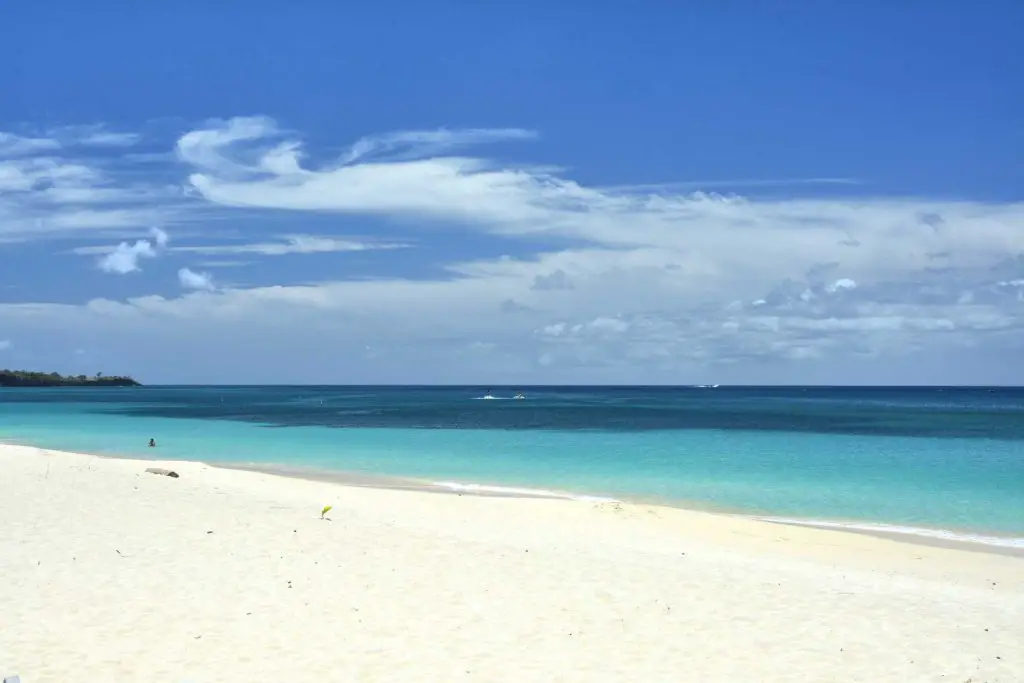

Tours & Excursions
Some of us don’t mind parking it on a beach chair for a week. Yet others want to get up, move, and explore the island. Both Grenada and Jamaica have a variety of professional tour operators and companies available to guide you when you’re ready to roll off that beach chair.
Popular tours on both islands include waterfalls, Jeep and UTV excursions, Catamaran cruises, scuba diving & snorkeling, as well as historical tours.
Waterfalls got your attention? Check out The Ultimate Guide to Grenada’s Waterfalls.
Enough about the similarities, let’s dig into the differences between Grenada and Jamaica so you can make a final decision and start planning your getaway!
Grenada and Jamaica Differences
OK, let’s get into the differences between these two amazing islands. If you don’t know the differences you might as well flip a coin and go wherever.
Grenada Geography
An island nation located in the south of the Caribbean, Grenada offers a diverse landscape for an island getaway. It sits on the Lesser Antilles arc, a volcano chain that runs through the Caribbean. This means that the landscape has been formed by volcanic rock and still features dormant volcanos as well as crater lakes.

The islands feature looming mountains, rugged coastlines, and the crystal blue beaches one would expect from a Caribbean island. The country also receives high levels of rainfall and is therefore blessed with thick, lush vegetation. This environment provides many hiking opportunities for tourists and the chance to observe the wildlife in Grenada.
The island nation comprises three large islands (Grenada, Carriacou, and Petit Martinique) and numerous smaller, uninhabited islands.
Grenada consists of more than 20 islands. Wanna learn more? Check out The Number of Islands in Grenada (Including the Tiny Ones).
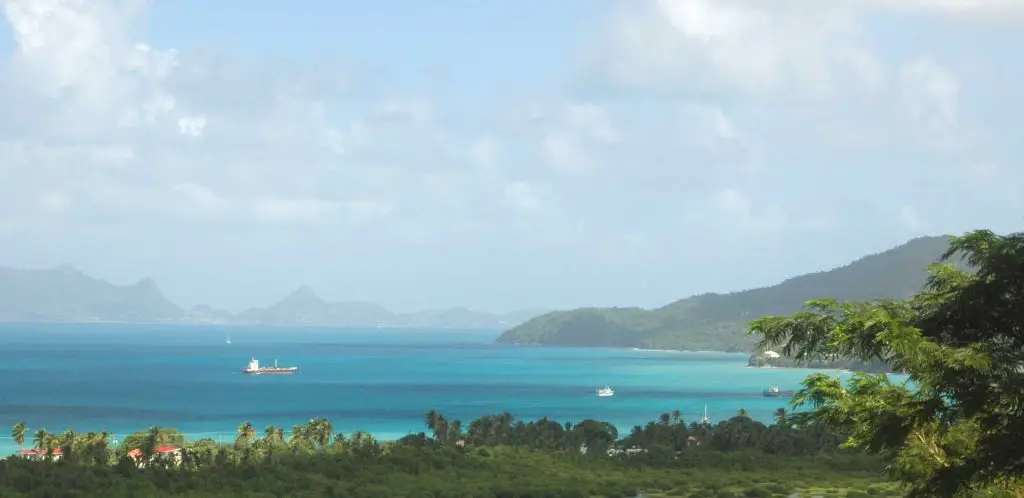
Grenada is the biggest of all the islands, with an area of 120 miles. It’s home to the country’s capital, St George’s, and has an international airport making it easy for travelers to get to the country. Carriacou also has an airport, although it is small and only services domestic flights, while Petit Martinique and the other islands are only accessible by boat.
The mountainous terrain of the country means the elevation varies, typically ranging from 1,000 feet below sea level to 2,000 feet above sea level. The highest peak is Mount St. Catherine on Grenada island, which reaches 2,755 feet tall.
The climate is typical of a tropical island destination and remains consistently warm and humid throughout the year. The average temperature stays right around 82 degrees Fahrenheit year-round, and there is substantial rain, keeping the rainforest lush and green.
Still, visiting Grenada during the rainy season is not a bad idea. Learn why: When is Grenada’s Rainy Season and What’s It Like?.
Grenada Culture
Grenada has a unique culture that stems from its diverse ethnic origins. The people of Grenada have ethnic backgrounds from a range of places, including Britain, France, Africa, and the West Indies, and this has created a true blended culture.
English is the official language of Grenada, although there are two creole languages that are also commonly spoken: Grenadian English Creole and Grenadian French Creole.
Given the diversity of its origins, Grenada has a culture that incorporates customs and traditions from all over the world. The African influence is strong and evident in the way the country conducts festivals, as well as through music and dance.
Grenada Crowds/Tourist Areas
Grenada is becoming an increasingly popular tourist destination having welcomed over 500,000 visitors in 2019. However, unlike some other Caribbean islands has still retained a relaxed island feel.
There are plenty of tourist attractions in Grenada and the infrastructure to support visitors. However, people are still able to get away from the crowds and enjoy nature. Tourism continues to develop with more building occurring, so this may change over the coming years.
Grenada Food
The food in Grenada, like its culture, has been influenced by a range of ethnicities. Tourists will find a variety of foods, including local dishes that range from seafood options, African cuisine, and Indian spices.
In general, spices are very popular in Grenada, with the country even being known as ‘The Spice Isle.’ A dish called ‘oil down’ (essentially a stew cooked in coconut milk) is a staple in Grenada.
Did you know Grenada is known as the Spice Isle? Here’s why-> How Grenada Became Know for Being the Spice Isle.
Grenada Travel Advisory Level
The US State Department is tasked with keeping its citizens safe when traveling abroad. As part of that objective, they assign a travel advisory level to each country which is intended to provide travelers with the overall safeness to travel there.
A ton more detail is found on the US State Department’s website. including specific areas in the country that are of concern (if there are any) and why.
Here’s the state department’s advisory levels and their general meaning.

Grenada’s Travel Advisory Level is currently 1 and Jamaica’s Travel Advisory Level is currently 2. Seemingly, based on this information alone, Grenada would be a safer choice.
Wherever you decide to go, always check the state department’s website for a current travel advisory level as they can change. I also encourage you to visit their website to read up on why any level above 1 is assigned that level.
I also wrote an article to answer the question “Is Grenada Safe for Tourists”. It compares real crime statistics across the Caribbean islands. Is Grenada Safe for Tourists?
Grenada Hurricane Likelihood
No Caribbean island is 100% safe from hurricanes, Grenada is no exception. However, Grenada’s location in the Caribbean enables it to be much less susceptible to hurricanes than their northern counterparts like Jamaica., the Bahamas, the Cayman Islands, Turks & Caicos, etc.
The chart below shows the number of hurricane hits to the Caribbean islands in the last 100 years. Grenada has been hit far less compared with just one region of Jamaica. (The table below compares Caribbean islands of similar size for a fair comparison of hurricane hits. For that reason, just one area of Jamaica is included rather than the entire island which is far larger than Grenada).
| Caribbean Island | Hurricane Hits |
| Aruba/Curacao/Bonaire | 2 |
| Grenada | 4 |
| Barbados | 4 |
| Negril, Jamaica | 7 |
| Santo Domingo, Dominican Republic | 8 |
| Puerto Rico | 9 |
| St. Thomas USVI | 11 |
| Cayman Islands | 16 |
| Turks & Caicos | 16 |
| St. Martin | 16 |
| Grand Bahama, Bahamas | 22 |
Being less susceptible to hurricanes makes Grenada a great vacation option year-round, even during the hurricane season ( generally June – September).
To get the full scoop on hurricanes hitting Grenada, you must check out here: Do Hurricanes Hit Grenada?
Jamaica
Jamaica Geography
Jamaica also has a volcanic origin and offers three distinct landscapes: mountains to the east, valleys and plateaus in the center, and flat coastal areas.
The third-largest island in the Caribbean, Jamaica is renowned for its white-sand beaches and crystal blue oceans. Two-thirds of the country is covered by limestone, which has created a range of caverns and scenic valleys just waiting to be explored.
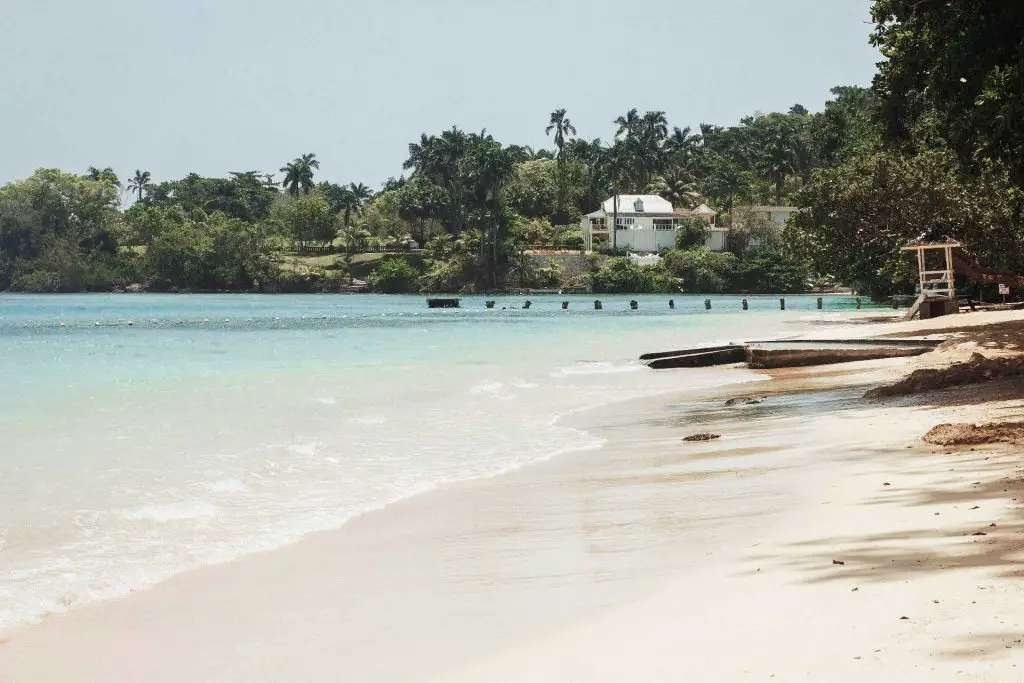
Photo by Lakeisha Bennett on Unsplash
The east of Jamaica, where the mountains are, has high elevation with the tallest peak, Blue Mountain Peak, standing at 2256 meters tall. There is a range of notable mountain ranges to visit in Jamaica, including Manchester Plateau, Dry Harbour, and John Crow.

Jamaica also has a tropical climate with warm temperatures throughout the year. There isn’t much difference between winter and summer, with the average temperature ranging from 30 degrees Celsius to 33 degrees Celsius year-round.
The south coast is the warmest part of Jamaica, although this isn’t great variance throughout the country. The seasons in Jamaica are differentiated by the amount of rain the country receives. The rainy season is hot and humid, lasting from April to October.
Jamaica Culture
The Jamaican culture has a strong British influence, combining influences from Africa and Europe. Tourists in this country will observe how these two aspects have come together, both having a strong influence on how Jamaicans live today.
African culture lives through religion, food, music and drumming, dance, the Jamaican Creole language, and traditional medicine (spiritual healing and herbal treatments). Stories from an African origin have also been passed down through the generations. The European influence is evident thought the presence of Christianity, modern medicine, and the arts.
The official language of Jamaica is English. However, Jamaican Patois is more widely spoken. Jamaican Patois, also known as Jamaican Creole, originated during the slave trade era.
The Jamaican culture is very much focused around family, with three generations commonly sharing the one household. All members help raise children, with grandmothers typically caring for younger individuals when parents are at work.
Despite the common association of Rastafarians and Jamaica, people belonging to this group only make up a small component of the population. Instead, travelers can expect to see a fusion of cultures with primarily European and African influences.
Jamaica Crowds/Tourist Areas
Jamaica is a more established tourist destination than Grenada and gets quite busy during peak time. It is a large island that is difficult to get around without a car, so it is always possible to hire one and get off the beaten track to avoid the vacation chaos.
Jamaica Food
Jamaican food is centered around what is fresh and available. Just like Grenada, the Jamaican culture is a melting pot of different ethnicities, which has created a unique cuisine.
The food is influenced by a range of ethnicities, including European, African, Chinese, and Spanish, and combines a unique mixture of flavors.
The national dish in Jamaica is Ackee and Codfish, although this may not be to everyone’s tastes. Ackee is a fruit that is cooked and served with the fish, almost having the consistency of scrambled eggs. This dish is served for breakfast. The Jamaican diet is typically made up of fruits, vegetables, fish, and meat.
Jamaica Travel Advisory Level
Here I’ll reiterate what was mentioned above for Grenada. I want to avoid steering you in the direction of one island or the other because one is or isn’t’ safer than the other. You need to educate yourself and make a decision that’s right for you.
The US State Department is tasked with keeping its citizens safe when traveling abroad. As part of that objective, they assign a travel advisory level to each country which is intended to provide travelers with the overall safeness to travel there.
A ton more detail is found on the US State Department’s website. including specific areas in the country that are of concern (if there are any) and why.
Here are the state department’s advisory levels and their general meaning.

Grenada’s Travel Advisory Level is currently 1 and Jamaica’s Travel Advisory Level is currently 2. Seemingly, based on this information alone, Grenada would be a safer choice.
Wherever you decide to go, always check the state department’s website for a current travel advisory level as they can change. I also encourage you to visit their website to read up on why any level above 1 is assigned that level.
Jamaica Hurricane Likelihood
Jamaica and its northern counterparts experience far more hurricane hits than Grenada.
The chart referenced earlier shows the number of hurricane hits to the Caribbean islands in the last 100 years. It’s clear Jamaica’s hits far outnumber those of Grenada. If you’re interested in the nitty-gritty details behind why hurricanes hit some areas more than others, check out my article that totally nerds out on the science part of it -> Do Hurricanes Hit Grenada?
Which should you choose? Grenada or Jamaica?
While Grenada and Jamaica offer a similar landscape (stunning beaches, lush vegetation, mountain ranges), they each have a slightly different feel.
Grenada offers old-school charm, with a simpler and authentic island experience for travelers. It is less developed and would appeal to tourists interested in getting away from tourist hotspots.
Jamaica, on the other hand, is one of the most popular tourist destinations in the Caribbean. It offers every comfort a tourist could want – restaurants, bars, tours, a range of accommodation options – while also providing a unique culture.
If you are looking for choices in your vacation getaway Jamaica is much more established and offers more guided tours and classic tourist experiences, while Grenada is a little more untouched.
Although not a guarantee, if you’re looking to travel between June and September, Grenada may be a better choice with far fewer hurricane hits.
Summary
- Grenada and Jamaica both offer stunning landscapes. If you are looking for white-sand beaches, thick jungles, and mountain ranges, either country will deliver.
- Both Grenada and Jamaica have diverse cultures influenced by a range of ethnicities. The diverse ethnic origins of these countries can be seen through their customs, languages, and food.
- Grenada and Jamaica are both great island destinations. People looking for a more ‘off-the-beaten’ track destination should opt for Grenada, while tourists looking to hit up an established travel hotspot will enjoy Jamaica.
- If you’ve been to Jamaica and in a “been there done that” mood, check out Grenada for a new, fresh Caribbean experience.
Have you been to Grenada and Jamaica? I’d love to know which island you loved most. Hit me up with a comment below.

